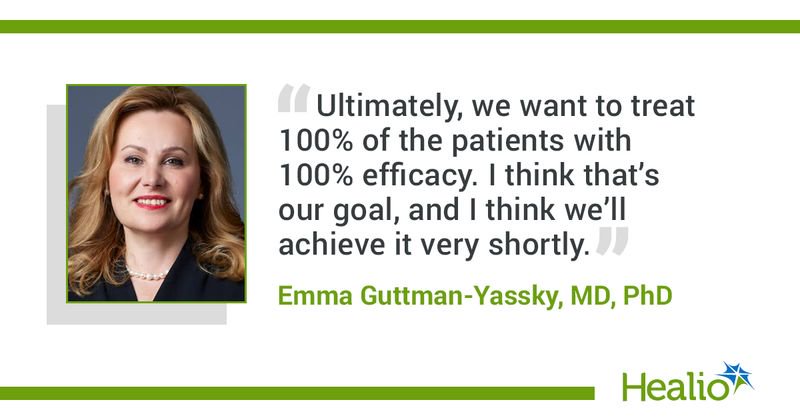Q&A: National Eczema Awareness Month highlights ‘hopeful time’ in treating skin condition
Key takeaways:
- Rocatinlimab is currently being studied as a long-term treatment for eczema.
- New drugs that specifically target IL receptors are being researched.
October is National Eczema Awareness Month. It serves to bring attention to the approximately 16.5 million adults and 8 million children in the U.S. that currently suffer from the chronic skin condition.
In honor of this month, Healio spoke with Emma Guttman-Yassky, MD, PhD, Waldman Professor and System Chair of the Kimberly and Eric J. Waldman Department of Dermatology and director of the Center of Excellence in Eczema and the Laboratory of Inflammatory Skin Diseases at the Icahn School of Medicine at Mount Sinai.

Guttman-Yassky discussed current eczema treatments and their limitations, as well as a promising new treatment, rocatinlimab (Kyowa Kirin, Amgen), that targets memory T cells, offering hope for a longer-lasting treatment.
Healio: What are the current treatments for eczema?
Guttman-Yassky: Depending on severity, there are topical treatments for patients with mild to moderate disease. For patients with moderate to severe disease, it’s very clear that they need more than a topical treatment. They also need systemic treatments.
We have monoclonal antibodies, the injectables, such as dupilumab (Dupixent; Regeneron, Sanofi) and tralokinumab (Adbry, LEO Pharma), and recently we now also have lutikizumab (ABT-981, AbbVie). Additionally, lebrikizumab-lbkz (Ebglyss, Eli Lilly and Company) was just approved by the FDA on Sept. 16.
Healio: What are some of the limitations that you are finding with these treatments?
Guttman-Yassky: Often existing treatments are needed on a regular basis. The moment you stop, or several weeks later, the disease usually will come back, which depends on the type of treatment and the severity of the patient.
Another limitation is that there is no “one-size-fits-all” treatment. Each treatment leaves quite a large number of patients still not fully controlled. So, we need better treatment that will improve more patients, and we also need treatments that we will be able to give less often, and maybe when we stop them, the disease will not come back.
Healio: How does rocatinlimab build on these limitations, and how is it different from the others?
Guttman-Yassky: Rocatinlimab is a treatment that modifies activated memory cells. These are the cells that populate areas that used to be lesions, but then when they recur, they recur exactly in the same area. It’s because of these memory T cells. Rocatinlimab specifically targets these cells, raising the possibility of longevity of response.
Healio: Could you give us an overview of the current phase 3 ROCKET HORIZON rocatinlimab trial?
Guttman-Yassky: In the current trial, we only got a glimpse of what happened at week 24, which was the primary endpoint. But for this type of treatment, I’m even more intrigued to see what will happen later because we know that at 24 weeks rocatinlimab did not likely achieve its maximum response. And what happens when people stop and restart? The study was positive in the sense that the drug achieved significance compared with placebo. It was administered once every 4 weeks. The dose is not yet disclosed. So, I think we'll hear more about other later endpoints and what happens when you stop the drug — how long would you maintain efficacy?
Healio: What is the next step in the study?
Guttman-Yassky: The next step is to, first of all, see the later endpoints of this study because, again, I think with this type of target, we need to judge it for a longer time period and also on the longevity of response. What happens when we stop it? I would like to see what happens at 1 year, see if the vast majority of patients are clear, and what happens when you stop the drug and whether the disease doesn’t come back and for how long. I think those will be very important questions to answer with this type of treatment.
Healio: What are some other advances in eczema care that you would like to share with others besides this?
Guttman-Yassky: It’s a very hopeful time. There is also OX40-ligand from Sanofi, amlitelimab, that is being studied for eczema also in phase 3, targeting OX40L that is a part of the same pathway. There are some exciting treatments targeting the IL-22 receptor and a study targeting the IL-31 receptor.
We are hoping for approval for nemolizumab (Nemluvio, Galderma) targeting the IL-31 receptor, and we want to see what happens with the IL-22 receptor targeting. There are some new treatments targeting IL-18, and also some bispecific or trispecific treatments, so it’s a very exciting time in atopic dermatitis.
Healio: Anything else you would like to share?
Guttman-Yassky: I want to say that I think we are changing the paradigm for treatment for our eczema patients. Ultimately, we want to treat 100% of the patients with 100% efficacy. I think that’s our goal, and I think we’ll achieve it very shortly.
Reference:
- Eczema stats. https://nationaleczema.org/research/eczema-facts/. Accessed Oct. 16, 2024.
